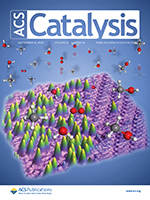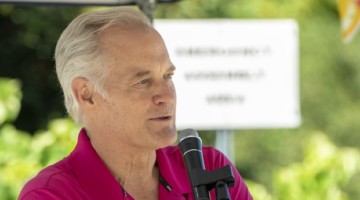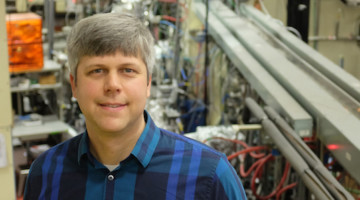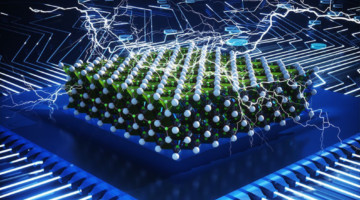Inverse catalysts generally consist of oxide nanoparticles supported on metal substrates, which can exhibit exceptional catalytic properties. The small SnO2 nanoparticles uniformly dispersed on a Cu2O/Cu(111) substrate enabled a unique SnO2–Cu2O interface that can completely convert methane to methanol directly under the environments of oxygen and water. Read more »
All News & Updates
August 2022 Message from the UEC
Ming Yi, UEC chair, celebrates a successful User Meeting. This year’s virtual meeting has inspired new ideas for ways to bring science to more people in the future. She encourages the user community to get involved by submitting feedback or even joining the UEC. Keep an eye out for the call for new member nominations. Read more »
Valeriy Yashchuk Receives 2022 Klaus Halbach Award
Valeriy Yashchuk aims to make the binary pseudo-random calibration tool (BPR) the internationally recognized standard for thorough characterization of a broad spectrum of topography measuring tools. Others might find it daunting to convince scientists around the world to agree on one standard, but Yashchuk is accustomed to roadblocks, and finding creative solutions to them. The ALS Users’ Executive Committee recognized Yashchuk, program lead for metrology, for developing this critical technology. Read more »
Steve Kevan Says, “See You Soon!”
After announcing his impending retirement earlier this year, ALS Director Steve Kevan has worked to ensure a smooth transition to the interim ALS management team. He shares his vision of the collaborative future of the ALS and his goal to return as a user before saying not a farewell, but a “see you soon!” Read more »
Interim ALS Leadership Team Announced
Effective September 1, ALS Science Deputy Andreas Scholl will be the interim ALS director, and Head of Strategic Development and Communications for Energy Sciences and ALS Communications Director Ashley White will serve as interim deputy for strategy, alongside Operations Deputies Steve Rossi and Fernando Sannibale. Read more »
Scientists Grow Lead-Free Solar Material With a Built-In Switch
A new ferroelectric material—grown in the lab from cesium germanium tribromide (CGB)—opens the door to an easier approach to making solar cell devices. Unlike conventional solar materials, CGB crystals are inherently polarized, where one side of the crystal builds up positive charges and the other side builds up negative charges, no doping required. Read more »
Call for 2021 and 2022 Publications
All publications resulting from work done in whole, or in part, at the ALS must be recorded by the User Office for the Department of Energy (DOE). Please help ensure our records are complete by reporting your ALS publications, especially those published in 2021 and 2022. Read more »
Kevan Anderson and the BCG Receive 2022 Renner User Services Award
At this year’s ALS User Meeting, Kevan Anderson, on behalf of the Beamline Controls Group (BCG), was honored with the 2022 Tim Renner User Services Award. The ALS Users’ Executive Committee made the selection for “broad expertise in control systems and software development, and professional judgment and decision-making, which have greatly contributed to the research and development program of the Advanced Light Source.” Read more »
Multilayer Stack Opens Door to Low-Power Electronics
Researchers found that a multilayer stack of ultrathin materials exhibits a phenomenon called negative capacitance, which reduces the voltage required for transistor operation. The material is fully compatible with today’s silicon-based technology and is capable of reducing power consumption without sacrificing transistor size or performance. Read more »![]()
![]()
2022 User Meeting Highlights
The ALS User Meeting was held August 15–17, 2022, co-chaired by UEC members Hope Michelsen, Yu He, and Rourav Basak. With Steve Kevan’s retirement and the approaching ALS-U implementation phase, the overarching theme of this year’s User Meeting was a celebration of the glorious past and anticipation of a very bright future. Read more »
- « Previous Page
- 1
- …
- 33
- 34
- 35
- 36
- 37
- …
- 139
- Next Page »








